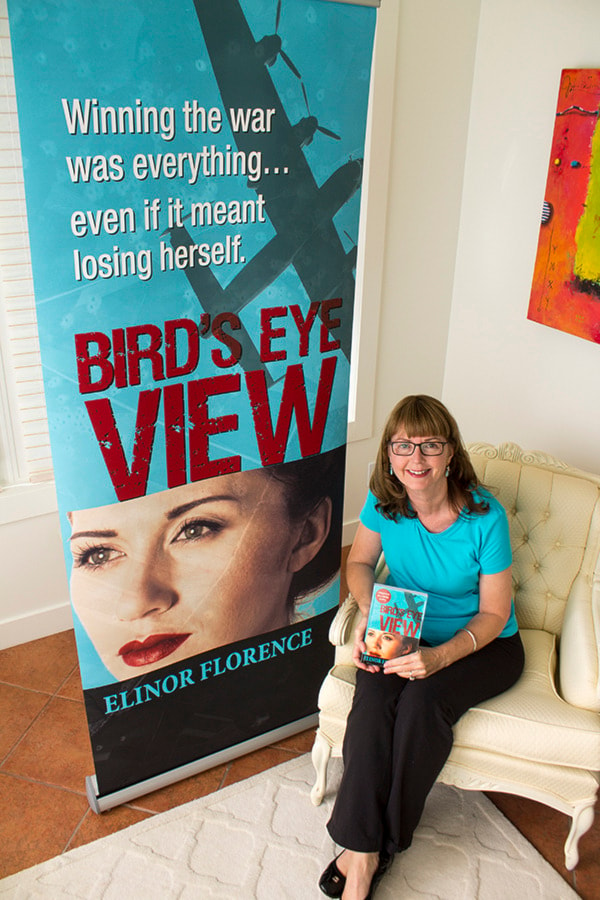Author Elinor Florence, who’s fascinated with the role women played in Canada’s military history, is inviting the public to an engaging slideshow presentation at the Penticton Public Library on Nov. 21.
Her novel Bird’s Eye View, which was released late last year, is fact-based fiction about a woman who left home from her farm in Saskatchewan to lend her skills in Europe as an aerial photographic interpreter. Much of the story’s content came about through Florence’s upbringing in North Battleford, Sask., her studies of women in the Canadian military and her father’s contribution in the Second World War.
While listening to her father’s stories, she came to realize the masculinity of men in the military is overinflated.
“He told me that at night, especially in the beginning when they hadn’t been away for very long when it was lights out in the barracks, you could hear boys crying themselves to sleep,” she said. “That really resonated with me because you always think about these big tough guys going off with their guns into battle, but they were really just scared, homesick, lonely boys.”
Florence said the most effective way for the military to counteract its soldiers’ morale from diminishing was to connect them with letters from home, written by loved ones and strangers alike.
“It was considered your patriotic duty to write letters because some of the boys overseas didn’t have parents or anybody to get letters from,” she said. “It was common for all the girls in town to gather in groups and write letters together, knit socks, and they would stick notes in the tips of the socks saying something like ‘Good luck from your friend in Canada,’ so that the boys always had something to open when it was mail call.”
During the war, Florence said the Royal Canadian Air Force employed a special squadron that did nothing other than fly mail from Ottawa to Scotland, where it was shipped to London and then delivered to every post where Canadians were serving.
Florence has noticed that combative roles in the military garnered more exciting stories, and because those positions were served exclusively by men, she feels the contribution of women in the Second World War has been eclipsed.
“The history books tend to focus on combat obviously which is understandable,” she said. “But even though the women weren’t risking their lives they were making a major contribution to the war effort.”
Most aerial photograph interpreters during the war were women, Florence said, just like the heroine of Bird’s Eye View. Their role was to analyze enemy territory with black and white photos taken by airplane.
“There’s very little in the history books about women in uniform and photo interpretation so I really had to dig deep to find any information,” she said. “We hear a lot about the code breakers, and the photo interpreters would work closely with the code breakers because they were always trying to verify each others’ findings, trying to glean as much info as they could about what the enemy was up to.”
Florence jokes the role requires the interpreters to make sense of 50 shades of grey, since the images they had to study could seem like a big blur.
“There was no satellite imagery, all they had was black and white photographs taken at high altitudes and they just studied these under a magnifying glass or a stereoscope.”
The heroine has almost a supernatural talent for aerial interpretation, Florence said. “And there were people just like that, who just had kind of a sixth sense and were extremely skillful at being able to read an image.”
Florence said Bird’s Eye View is the only novel to date that features a Canadian woman in uniform as the main character.
“Which I think is a little bit sad because there were 50,000 women who volunteered in the Second World War and served their country faithfully.”
The current perception of women in the military has taken a big shift since the Second World War, Florence said.
“During the Second World War, women were paid two-thirds the wages of men even if they were doing identical work, and when the war ended they were all kicked out and told to go home,” she said. “Women have achieved a great deal of equality, maybe not as much as they would like, but it’s a different world altogether, and these women in uniform were the real trailblazers.”
Because her fictitious story is so deeply rooted in the facts of history, readers often ask her to differentiate the truth from her imagination.
“So eventually I decided to put together a slideshow, a powerpoint presentation, and I prepared a talk in which I answered all of these questions and people really quite love it.”
She said Bird’s Eye View doesn’t require the reader to know anything about the Second World War to understand it.
“There are no historical references that aren’t explained, and how it fits in to the story, which sort of adds an educational aspect to it as well.”
Florence’s slideshow presentation will focus on how she originally became interested in wartime history, contributions made by Canadian women and discoveries that were made by aerial photographic interpreters. The talk begins at 4 p.m. and is free to attend. Attendees are encouraged to wear period clothing.
Florence also publishes Wartime Wednesday, a weekly blog about military history which can be read through her website elinorflorence.com/blog.
